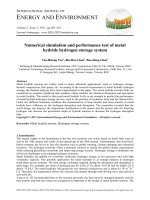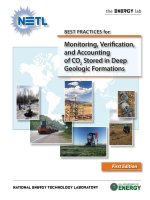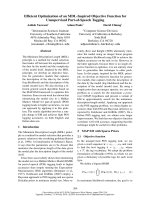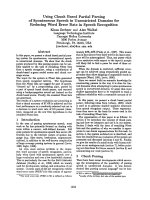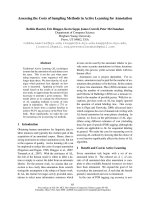Numerical simulation and optimization of CO2 sequestration in saline aquifers for enhanced storage capacity and secured sequestration
Bạn đang xem bản rút gọn của tài liệu. Xem và tải ngay bản đầy đủ của tài liệu tại đây (2.94 MB, 12 trang )
I
NTERNATIONAL
J
OURNAL OF
E
NERGY AND
E
NVIRONMENT
Volume 4, Issue 3, 2013 pp.387-398
Journal homepage: www.IJEE.IEEFoundation.org
ISSN 2076-2895 (Print), ISSN 2076-2909 (Online) ©2013 International Energy & Environment Foundation. All rights reserved.
Numerical simulation and optimization of CO
2
sequestration in saline aquifers for enhanced storage
capacity and secured sequestration
Zheming Zhang, Ramesh K. Agarwal
Department of Mechanical Engineering & Materials Science, Washington University in St. Louis, MO
63130, USA.
Abstract
Saline aquifer geological carbon sequestration (SAGCS) is considered most attractive among other
options for geological carbon sequestration (GCS) due to its huge sequestration capacity. However, in
order to fully exploit its potential, efficient injection strategies need to be investigated for enhancing the
storage efficiency and safety along with economic feasibility. In our previous work, we have developed a
new hybrid code by integration of the multi-phase CFD simulator TOUGH2 with a genetic algorithm
(GA) optimizer, designated as GA-TOUGH2. This paper presents the application of GA-TOUGH2 on
two optimization problems: (a) design of an optimal water-alternating-gas (WAG) injection scheme for a
vertical injector in a generic aquifer and (b) the design of an optimal injection pressure management
scheme for a horizontal injector in a generic aquifer to optimize its storage efficiency. The optimization
results for both applications are promising in achieving the desired objectives of enhancing the storage
efficiency significantly while reducing the plume migration, brine movement and pressure impact. The
results also demonstrate that the GA-TOUGH2 code holds a great promise in studying a host of other
problems in CO
2
sequestration such as how to optimally accelerate the capillary trapping, accelerate the
dissolution of CO
2
in water or brine, and immobilize the CO
2
plume.
Copyright © 2013 International Energy and Environment Foundation - All rights reserved
Keywords: CO
2
sequestration; Computational fluid dynamics; Genetic algorithm; Injection pressure
management; Water-alternating-gas (WAG) injection.
1. Introduction
In recent years, there has been significant emphasis on the development and implementation of safe and
economical geological carbon sequestration (GCS) technologies due to heightened concerns on CO
2
emissions from pulverized-coal (PC) power plants. However, uncertainties about storage capacity as well
as long-term storage permanence remain major areas of concern before proceeding with the actual
deployment of CO
2
sequestration in large-scale aquifers with enormous investment. In addition,
challenges remain in enhancing the storage efficiency and safety (by reducing the extent of plume
migration, brine movement and pressure impact) as well as the energy efficiency and economic
feasibility of GCS by improving the injection operations. Numerical simulations prior to actual
sequestration can be employed to address some of these uncertainties. CFD solver Transportation of
Unsaturated Groundwater and Heat (TOUGH2) has been widely used for this purpose [1, 2]. Due to the
complexity of the mass/energy transport in GCS, injection strategies that may be beneficial in addressing
International Journal of Energy and Environment (IJEE), Volume 4, Issue 3, 2013, pp.387-398
ISSN 2076-2895 (Print), ISSN 2076-2909 (Online) ©2013 International Energy & Environment Foundation. All rights reserved.
388
one aspect of the sequestration (e.g. reduction in plume migration) may not be as effective in addressing
another important aspect of sequestration (e.g. reservoir pressure response and its management). In
addition, the storage efficiency of an aquifer is also dependent on various injection strategies and
parameters associated with them; the optimization of the storage efficiency of an aquifer is of great
interest in GCS. Therefore, a simulation tool that has the capability of determining the optimal solutions
by balancing various trade-offs among desired objectives in GCS is needed. As an effort to examine and
address these issues, we have developed a genetic algorithm (GA) based optimization module for
TOUGH2 which can optimally examine various injection strategies for increasing the storage efficiency
as well as reducing the plume migration (Zhang and Agarwal, 2012). It is designated as GA-TOUGH2,
and has been validated by conducting several benchmark studies [3, 4].
In this paper, we consider the optimization of two engineering techniques to increase the sequestration
efficiency and safety of GCS in saline aquifers. In the first study, we employ a water-alternating-gas
(WAG) injection technique to a generic saline aquifer to retard the vertical migration of in situ CO
2
, i.e.,
to reduce the CO
2
plume size. In the second study, our goal is to seek a particular CO
2
injection scenario
that will result in the management of injection pressure (with the constraint that it remains less than the
aquifer’s fracture pressure) so as to maximize the injection rate to increase the storage efficiency. In both
the studies, we would like to determine the optimum strategy to achieve the desired objective. In the
WAG injection scheme, the additional water injection results in greater pressure response and energy
consumption which needs to be traded off with the goal of reduced CO
2
migration in an optimal manner.
Optimization can help in determining the most efficient as well as effective WAG operation. For the
injection pressure management study, the goal is to manage the injection pressure such that it optimizes
the storage efficiency of the aquifer. The optimization results for both applications show great promise,
by significantly reducing the CO
2
migration (up to 50% reduction in plume size compared to
conventional CO
2
injection) and well regulated injection pressure (less than the formation's fracture
pressure) to increase the storage efficiency.
2. Methodology
In previous research, we successfully developed an optimization module for TOUGH2 using a genetic
algorithm (GA). GA belongs to a class of optimization techniques that are inspired by the biological
evolution [5]. It can iteratively converge to the global optima without having detailed information about
the design space. Implementation of GA-TOUGH2 is summarized in Figure 1. Details of this work can
be found in our previous papers [4, 6].
Figure 1. Dataflow schematic of GA-TOUGH2 numerical simulator
3. Optimization of WAG technique for reducing the plume migration
The storage efficiency of saline aquifer geological carbon sequestration (SAGCS), based on the aquifer's
pore space, is usually very low. This is due to the inherent nature that injected CO
2
is less dense than
brine, with which the aquifer is filled. Consequently, CO
2
tends to rise up to the ceiling (caprock) of the
aquifer and forms a large spreading plume, decreasing both the storage capacity, safety and economic
feasibility of SAGCS considerably. To address this problem, we examined the potential benefits of a
International Journal of Energy and Environment (IJEE), Volume 4, Issue 3, 2013, pp.387-398
ISSN 2076-2895 (Print), ISSN 2076-2909 (Online) ©2013 International Energy & Environment Foundation. All rights reserved.
389
reservoir engineering technique called water-alternating-gas (WAG) injection for carbon sequestration
compared to the constant-gas-injection (CGI) technique for its effect on both the storage capacity and the
plume migration. We employed GA-TOUGH2 to determine the most efficient injection pattern. As
shown later in this section, our calculations indicate that the adoption of WAG operation to SAGCS can
lead to significant gain in sequestration efficiency. One of the key parameters that determine the
migration of the in situ CO
2
is the mobility ratio M, defined as:
nwrn
wnrw
mk
M
mk
µ
µ
⋅
==
⋅
(1)
where
m
n
,
µ
n
, and
k
rn
are the mobility, viscosity, and relative permeability of the non-wetting phase (CO
2
)
respectively and
m
w
,
µ
w
, and
k
rw
are the mobility, viscosity, and relative permeability of the wetting phase
(brine) respectively. Typically a mobility ratio of 10~20 is expected for SAGCS with CGI operation.
Under the scenario of WAG operation, the alternating CO
2
-water slugs can be treated as quasi-mixture
entering the aquifer, leading to mobility ratio lower than that for pure CO
2
injection. The success of
WAG technique for SAGCS operations is supported by the following reasons: (1) lower
M
results in
more stable displacement of the reservoir fluid, (2) lower
M
reduces the upward migration of CO
2
[7],
and (3) injection of brine into the aquifer with or after CO
2
injection can accelerate the dissolution of
CO
2
and enhance its residual trapping by the enhanced convective mixing [8-11]. More details of the
benefits of WAG operation can found in the Appendix.
In the study of WAG operation, target CO
2
sequestration amount is set to be 0.5 million metric tons per
year, which is roughly half of the emission from a typical medium-sized PC power plant. For
demonstration purpose a WAG enabled SAGCS operation is assumed to last for 600 days before it is
shut down, although a typical lifespan of a PC power plant is around 30 years. Thus, a total of 0.822
million metric tons of CO
2
will be sequestered. During the 600 days of injection, 20 cycles of alternating
CO
2
-water slugs (each known as a single WAG cycle) will take place, as schematically shown in Figure
2. Four independent variables determine a unique WAG injection pattern: CO
2
injection rate, water
injection rate, WAG ratio (the injected CO
2
mass to injected water mass per cycle), and cycle duration.
Fitness function for optimization is defined as the CO
2
plume migration reduction (compared to the
migration under constant gas injection (CGI) operation) normalized by the total amount of water
injection, as given by Equation (2). The fitness function serves as the criteria for evaluating how efficient
a certain WAG operation would be. This choice of the optimization fitness function takes into
consideration both the performance and economic aspects of adapting the WAG operation, since the
water injection consumes extra energy for transportation and pumping. WAG injection pattern with the
largest fitness function value is most desirable. We define
CGI WAG
water
RR
fitness
m
−
=
(2)
where
R
CGI
and
R
WAG
are the CO
2
plume radius under CGI operation and WAG operation respectively.
m
water
is the total mass of injected water during WAG operation.
R
CGI
and
R
WAG
are measured at the top of
the reservoir due to the buoyancy of CO
2
. For simplicity, the following two assumptions are made: (a)
each WAG cycle has duration of 30 days and (b) all WAG cycles are identical to each other. The 30-day
cycle duration is chosen based on the authors’ judgment, following Nasir and Chong's conclusion that for
oil recovery purpose, different WAG cycle durations do not lead to significant difference in recovery
efficiency [12]. With these assumptions, the number of independent variables reduces to two. The
injection rates of CO
2
and the injection rates of water are chosen as the final optimization design
variables.
Optimization of WAG operation for a generic cylindrical aquifer with a vertical injector was
investigated. The principle of determining the size of the computational domain is that it should be able
to capture the CO
2
footprint until the end of simulation, and it should be sufficiently large so that the
boundary conditions have no significant effect on CO
2
migration. Following this principle, a hypothetical
cylindrical saline formation with radius of 3,000 m was modeled, while the radius-thickness ratio was set
to be 300. The injection well was located at the center of the domain above the bottom 20 m. Due to
International Journal of Energy and Environment (IJEE), Volume 4, Issue 3, 2013, pp.387-398
ISSN 2076-2895 (Print), ISSN 2076-2909 (Online) ©2013 International Energy & Environment Foundation. All rights reserved.
390
symmetry, only a radial slice of the domain was considered in the modeling. The computational domain
is shown in Figure 3 (a) in blue color (not to scale).
Figure 2. Schematic of the considered WAG operation
Figure 3. Computational domains for optimization of (a) WAG operation and (b) pressure management
Typical hydrogeological properties of a semi-heterogeneous saline aquifer with depth of 1,300m were
assigned to the simulation domain. No mass flow boundary condition was maintained at the ceiling and
the floor of the domain to simulate non-permeable cap-rock. Fixed-state boundary condition was applied
at the outer lateral boundaries of the domain, allowing the mass and energy to flow freely in and out of
the domain through the outer lateral boundaries as necessary. The fixed-state boundary condition
essentially represents an open system. Brine pumping was not modeled in the simulation domain by
assuming that the saline aquifer is sufficiently large and that the brine production is sufficiently far away
from the storage site; therefore, the induced CO
2
directional flow due to the presence of brine production
well is negligible. Steady-state simulations were conducted prior to the simulations of interest to
establish equilibrium condition throughout the domain. The equilibrium conditions were then used as the
initial conditions for the simulations of interest. Table A1 in the Appendix summarizes the details of the
domain properties.
Since it is inevitable that CO
2
will eventually rise and concentrate near the ceiling (caprock) of the
aquifer, the saturation of gaseous phase (SG) near the top-most layer of the simulation domain is
examined to estimate the CO
2
migration. In the plan-view of the top most layers, the final shape of the
CO
2
plume is expected to be circular due to the assumption that the formation properties of the aquifer
are homogenous. Table 1 gives details of the optimal WAG operation for each WAG cycle.
Table 1. Optimal WAG operation (per cycle)
I
CO2
(kg/s) Injection
duration (day)
I
water
(kg/s) Injection
duration (day)
WAG
ratio
Optimization fitness
(m/1000 tons of water)
36.13 13 33.35 17 0.847 0.1438
International Journal of Energy and Environment (IJEE), Volume 4, Issue 3, 2013, pp.387-398
ISSN 2076-2895 (Print), ISSN 2076-2909 (Online) ©2013 International Energy & Environment Foundation. All rights reserved.
391
The lateral extent of the CO
2
plume is determined by examining the gaseous phase distribution at the
ceiling of the aquifer. The intersection of the SG curve with the
x
-axis indicates the tip of the CO
2
plume,
i.e., the extent of CO
2
migration. Beyond this point, the aquifer is free from CO
2
contamination, so the
area up to this point is the CO
2
impact area. Any CO
2
leakage/contamination will occur only in the
impact area. Figure 4 shows the SG curve in the top-most layer of the simulation domain for optimized
WAG scheme and its comparison with SG curves obtained by three other non-optimized injection
schemes. The three other schemes are constant-gas-injection with low injection rate (low-CGI), constant-
gas-injection with high injection rate (high-CGI), and cyclic CO
2
injection. For the low-CGI case, CO
2
is
injected with a constant mass flow rate of 15.85 kg/s for 600 days; for the high-CGI case, CO
2
is injected
with a constant mass flow rate of 31.71 kg/s for 300 days; the cyclic CO
2
injection is the same as the
optimized WAG operation but without water injection. All cases have identical amount of sequestered
CO
2
as 0.822 million metric ton during the 600 days of operation.
Figure 5 shows the SG contours for the optimized WAG and non-optimized injection operations after
600 days of injection at the radial cross-section of the modeled formation.
Table 2 provides a detailed comparison among the optimized WAG and other three non-optimized
injection operations. The improvement (i.e., reduction) in plume migration is prominent.
The results presented above clearly show the benefits of the WAG operation for CO
2
sequestration.
However, we need to address the tradeoff of these benefits – i.e., the effect on other sequestration
variables, particularly the pressure, for ensuring the safety of sequestration. Pressure plays a crucial role
in ensuring the efficiency and safety of sequestration. According to the present investigation, adopting
the optimized WAG injection will cause the injection pressure to oscillate as the CO
2
injection and water
injection alternates. Considering the peak pressure under the optimized WAG injection, an 8% increase
of reservoir pressure from its pre-injection hydrostatic condition is found near the injection well.
Compared to this increase, a maximum of 2% increase in reservoir pressure is likely to be induced by the
three non-optimized injection scenarios. Although injection condition under WAG injection is harsher
due to increased injection pressure, it is not a cause of concern since the increase in injection pressure
due to WAG is small. However, it should be noted that the reservoir pressure response to the injection of
CO
2
and water is very sensitive to the hydrogeological properties of the saline formation, such as
porosity and permeability. Thus pressure analysis of WAG injection for different saline formations
should be made on a case-to-case basis. Figure 6 illustrates the injection pressure response for the four
injection scenarios studied.
0
0.1
0.2
0.3
0.4
0.5
0.6
0.7
0.8
0.9
0 50 100 150 200 250 300 350 400 450 500
Saturation of gaseous phase
Distance from domain center (m)
Cyclic CO2
Low rate CGI
High Rate CGI
Optimized WAG
Figure 4. SG underneath the caprock, optimal WAG and non-optimized injection operations
